The Role of Used Telehandlers in Agriculture
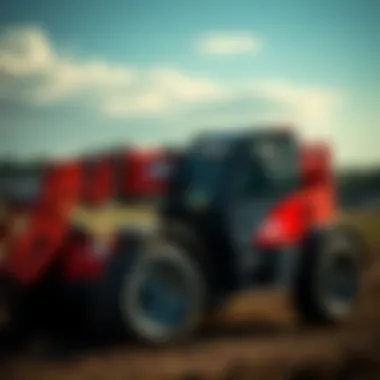

Intro
In the world of agriculture, when it comes to lifting and transporting materials, telehandlers have earned their rightful spot in the spotlight. These versatile machines act like a jack-of-all-trades on a farm. They can lift heavy loads, move bales of hay, or even stack pallets, all while offering the operator a clear view of their surroundings. However, the focus of our discussion lies in the landscape of used telehandlers. With their ability to provide significant savings without sacrificing quality, used telehandlers are becoming quite the popular choice for farmers and agronomists alike.
Understanding the nuances of used telehandlers isn’t just about grabbing the best deal – it’s about recognizing their added value to agricultural productivity and sustainability. This article aims to shed light on these aspects, diving into the practicalities of acquiring and maintaining used equipment, while spotlighting the trends and innovations resurfacing in the industry. Let’s explore why investing in used telehandlers can be a game changer for modern farming.
Prelims to Telehandlers in Agriculture
In the ever-evolving landscape of agriculture, telehandlers have carved a niche for themselves by bringing versatility and efficiency to farm operations. These machines are not only crucial for daily tasks but also serve as a bridge between traditional practices and modern advancements in farming techniques. By exploring telehandlers, particularly used ones, farmers can tap into cost-effective solutions while boosting productivity and sustainability.
Understanding telehandlers and their significance within agricultural contexts is profound. It isn't merely about lifting and moving materials; it transcends into enhancing operational dynamics and supporting diverse farming activities. With factors such as land size, crop type, and available technology continuously changing, telehandlers emerge as a pivotal tool that adapts to varying needs.
Definition and Functionality
At their core, telehandlers—or telescopic handlers—function as a blend between a forklift and an all-terrain vehicle. They are equipped with a telescoping boom that enables operators to lift loads high up and reach otherwise inaccessible areas. The versatility lies not just in their lifting capabilities, but also in the wide array of attachments available. From pallet forks and buckets to specialized attachments for specific agricultural requirements, these machines can address a multitude of tasks on a farm.
Farmers can utilize telehandlers for tasks like:
- Loading and unloading materials (such as hay bales or pallets of feed)
- Raising irrigation equipment or supporting construction projects
- Handling livestock feed or moving fertilizers in bulk
This remarkable functionality allows farms to streamline loads and work more efficiently, regardless of the task at hand.
Historical Context
The history of telehandlers can be traced back to the late 1970s when they started gaining traction in the agricultural sector. The initial machines were rudimentary, primarily designed for lifting heavy bales and construction materials; however, with advancements in technology, their design and functionality have significantly evolved.
By the 1990s, the introduction of hydraulic systems and improved stability allowed these machines to scale new heights—quite literally. As farms became larger and more mechanized, telehandlers found their way into mainstream agricultural practices. Farmers began recognizing them not only for their lifting capabilities but for their ability to increase efficiency across varied tasks, from planting to harvesting. Their rise parallels the evolution of agricultural demands, signaling a shift toward more mechanization and precision farming.
"The telehandler is the Swiss Army knife of the agricultural world—versatile, efficient, and indispensable."
Today, telehandlers are regarded as an essential part of farm equipment, with innovations still shaping their future. Understanding this history offers farmers a context to appreciate the technology—a journey from mere lifting solutions to multifaceted implement that drives productivity forward.
By laying out the groundwork in this section, we set the stage for deeper exploration into the benefits, selection process, and operational aspects associated with used telehandlers in agriculture. This understanding serves as a solid foundation for farmers, agronomists, and agricultural advisors to make informed decisions.
Benefits of Used Telehandlers
In the ever-evolving field of agriculture, the integration of used telehandlers brings to the forefront a multitude of advantages that can bolster both operational efficiency and financial performance on farms. Choosing to incorporate used telehandlers isn’t merely about embracing cost-effective machinery; it’s a strategic decision that addresses various aspects such as productivity, technology access, and sustainability.
Cost Efficiency
The financial landscape of farming has often been described as a tightrope walk, where every coin counts and expenditures must be scrutinized. Used telehandlers present a remarkable opportunity for farmers to save significantly. By opting for pre-owned models, farmers can avoid the steep depreciation associated with brand-new machines. Consider this: a telehandler that’s just a few years old might cost 30-50% less than its new counterpart, all while still delivering robust performance in lifting and material handling tasks.
Not only do farmers save on acquisition costs, but they also gain from reduced insurance expenses. Older machines often require less financial investment to insure, giving farmers even more leeway to allocate resources elsewhere, whether that’s feeding livestock, investing in new technology, or simply stashing some cash for a rainy day.
"Investing in used telehandlers enables farmers to stretch their budgets and maximize output—essential for sustainable agricultural practices."
Access to Advanced Features
Even within the realm of used equipment, telehandlers are often loaded with features that enhance operations. Many used models come equipped with advanced hydraulics, enhanced lift capacity, and operator comfort features, all derived from their newer brethren. Farmers can take advantage of these features without the premium price tag.
Advanced technological features such as smooth delegation of tasks, stronger lift capacities, and improved maneuverability may be available even in older models. For instance, a farmer might find a used JCB 531-70 providing the same capabilities as a new machine but at a fraction of the cost. This accessibility to top-tier features not only boosts efficiency but also empowers operators, as they can manage loads more effectively and safely.
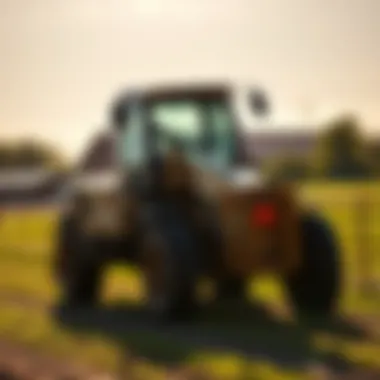
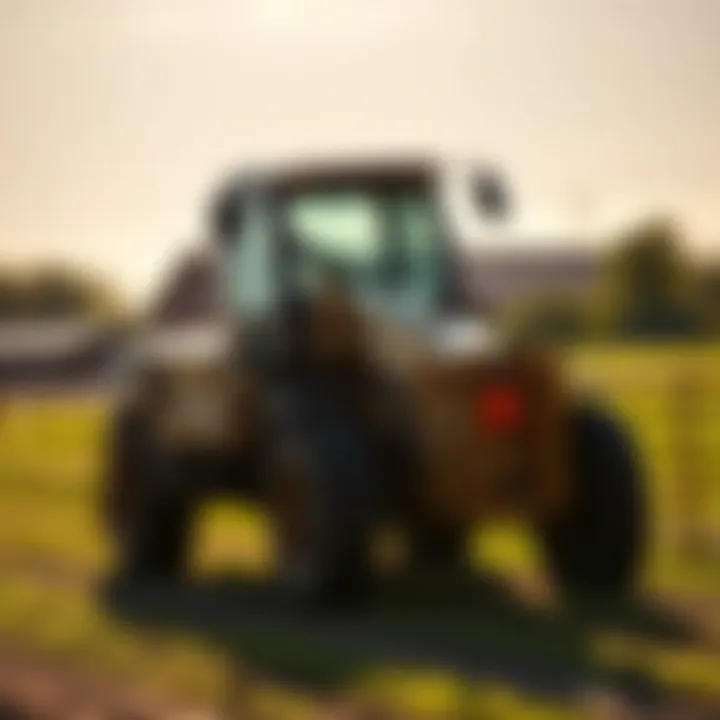
Sustainability Aspects
Selecting a used telehandler contributes to more sustainable farming practices by promoting a circular economy within the agricultural machinery sector. Instead of purchasing new, gas-guzzling machines that require extensive materials and energy to manufacture, farmers can choose to recycle resources by opting for used equipment. This decision reduces waste and minimizes the carbon footprint associated with production and transport of new vehicles.
Moreover, many used telehandlers are still efficient enough to pass modern emissions standards. They can serve as excellent workhorses while adhering to environmental regulations. This is crucial in a time when climate-conscious practices are becoming imperative, and integrating used machinery into operations shows a retailer commitment to sustainability.
Selecting the Right Used Telehandler
Choosing the right used telehandler is a crucial step for any farmer aiming to optimize their operations. Unlike other machinery, telehandlers are versatile machines that can perform a range of tasks, from lifting heavy loads to moving materials across uneven terrain. Therefore, a careful selection process ensures that you’re not just buying a machine but investing in an asset that can significantly enhance productivity, efficiency, and safety on the farm.
Assessing Equipment Condition
The condition of the telehandler is paramount. It's not just about looking at the shiny exterior; one must dive deeper. Start by examining the machine’s history. Has it been maintained regularly? Check for maintenance logs or service records; this is your first clue about its care over the years. Look especially at the following:
- Engine performance: Listen closely; a rough engine might indicate serious underlying issues.
- Hydraulics: If the hydraulic system is leaking or sluggish, steer clear. This can lead to costly repairs.
- Tires and Chassis: Worn-out tires or excessive wear on the chassis may hint that the machine has been subjected to heavy or improper use.
It’s sometimes helpful to bring along a knowledgeable mechanic who can assess not just the visible aspects but also the technical vitals of the machine.
Evaluating Specifications
Once you have a handle on the condition, it's time to delve into the specifications. Each telehandler model has its own strengths and weaknesses. Here’s where your specific farming needs come into play. Consider the following factors:
- Lift Height and Capacity: Ensure that the telehandler can lift what you need, whether that’s pallets of feed or heavy tools.
- Reach: Some tasks require extensive reach, such as stacking hay bales high or reaching over other equipment.
- Attachment Compatibility: Different jobs might call for forks, buckets, or even specialized attachments. Make sure the telehandler you select can accommodate these.
Evaluating specifications ensures that the telehandler won't just sit idle, but will actively contribute to the farm's productivity.
Considerations for Brand and Model
Not all telehandlers are created equal, and brand reputation plays a significant role in long-term reliability. Some brands are known for their robustness, while others are touted for their technological advancements. It can be wise to pay attention to:
- Market Research: Check forums or reviews on websites, like Reddit or agricultural machinery forums. Farmers often provide insights about their experiences with various brands.
- Resale Value: Some brands retain their value better than others. If you ever decide to sell or upgrade, this can factor heavily into your decision.
- Warranty and Support: Look into what's offered by the brand post-sale. Good customer support can save you many headaches if issues arise down the line.
Each of these considerations plays a vital role in ensuring that your chosen telehandler meets your operational needs while providing peace of mind.
"Investing in the right equipment isn’t just about the purchase cost; it's about total cost of ownership and operational efficiency."
By thoughtfully selecting the right used telehandler, farmers can set themselves up for success. It’s all about looking beyond the price tag and focusing on the value that machine can bring to the land.
Operational Considerations
When it comes to incorporating used telehandlers into agricultural practices, several operational considerations must be taken into account. Proper handling, integrated training, and diligent maintenance turn a used telehandler purchase into an asset rather than a liability. Understanding these aspects allows farmers to optimize productivity while ensuring safety and efficiency in their operations.
Training for Use
Training is not just a checkbox to tick off; it's a linchpin in leveraging the full capabilities of used telehandlers. With the variety of models and features on the market, farm workers must be well-versed in operating these machines safely and effectively. This training involves understanding the telehandler's controls, maneuverability, and attachment options.
Training should include:
- The fundamentals of operation, such as knowing the weight limits and understanding how the machine responds to load distribution.
- Hands-on experience with a simulator or on-site training sessions supervised by certified trainers. This helps users become accustomed to handling equipment under various conditions, from flat fields to inclined terrains.
- Instruction in troubleshooting common issues, which can minimize downtime. When workers know how to handle minor problems, they save the farm both time and money.
Consider: Continuous education as technology in telehandlers evolves. Short refresher courses can ensure that all users remain sharp and up-to-date with the latest trends.
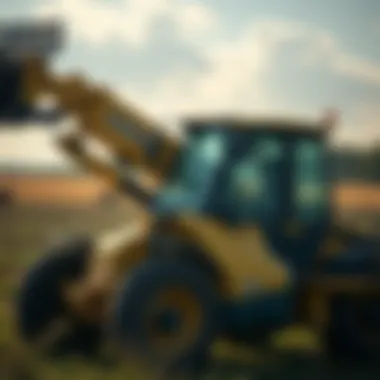
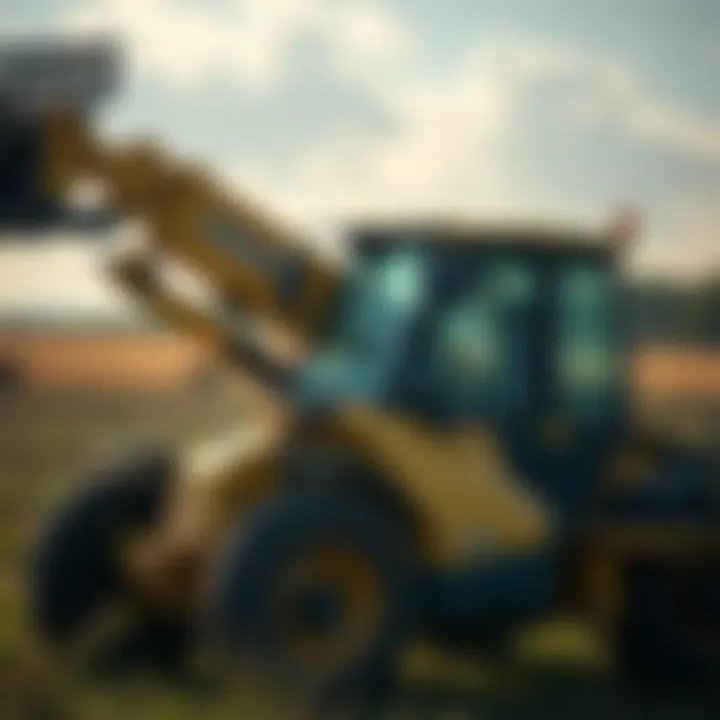
Maintenance Practices
Maintaining a used telehandler is akin to caring for a trusty old friend; neglect leads to wear and tear. Effective maintenance practices extend the life of the telehandler and enhance its performance. Regular checks and servicing should not be an afterthought but a structured routine in your operational calendar.
Key practices include:
- Daily inspections of critical components: fluid levels, tire conditions, and hydraulic systems should be examined before use.
- Keeping a meticulous logbook of maintenance activities for each telehandler. This record will aid in identifying patterns and potential areas of concern.
- Scheduling regular professional servicing intervals. Just like any other machinery, used telehandlers benefit from being evaluated by a certified mechanic who can spot issues that might not be visible to the untrained eye.
"A stitch in time saves nine"—while it may seem tedious, preventive maintenance is invaluable in avoiding costly repairs in the long haul.
Safety Protocols
Safety is paramount in any agricultural setting, and telehandlers are no exception. Incorporating robust safety protocols is essential not just for compliance, but for safeguarding lives. When it comes to telehandler operations, misconceptions and inattentiveness can lead to accidents, injuries, or even fatalities.
Crucial safety practices should include:
- Wearing appropriate PPE (Personal Protective Equipment) such as hard hats, safety glasses, and steel-toed boots, especially because telehandlers often operate in dynamic environments.
- Using spotters during operations involving tight spaces or heavy loads. Having someone to guide the operator can mitigate the risk of accidents.
- Communicating effectively among team members, employing standard hand signals or radios, ensures everyone is aware of movements and operations taking place.
Training in safety standards should be an ongoing effort, with clear reminders of protocol and a culture that encourages reporting unsafe practices without fear of reprimand.
In summary, focusing on these operational considerations enables farmers to maximize their investment in used telehandlers while enhancing efficiency and safety throughout their agricultural operations.
Impact on Farm Productivity
Telehandlers serve a vital role in enhancing productivity on farms. Their multifunctional capabilities and innovative technology can change the way agricultural work is done, leading to noticeable improvements in efficiency and output. By understanding how telehandlers impact farm productivity, farmers and operators can make informed decisions about their use, maximizing the return on investment for this specialized equipment.
One of the primary aspects to consider is the significant increase in efficiency that telehandlers provide on a daily basis. These machines are designed to lift and transport materials with ease, thus reducing the time spent on manual labor. Farmers can quickly move heavy loads, such as bales of hay, pallets of crops, and even tools, from one location to another. In effect, this means less time waiting around and more time spent on productive activities. Whether it’s feeding livestock or preparing for harvest, a telehandler can turn hours of work into mere minutes.
Additionally, there's the matter of versatility in application. Telehandlers come with a variety of attachments, allowing for use in diverse tasks. For instance, with the right attachment, a telehandler can function as a crane, enabling tasks like loading supplies onto high shelves in barns or structures. In cropping systems, operators can use buckets or forks to handle various materials efficiently. This flexibility allows farmers to utilize one piece of equipment for multiple tasks, which saves on both time and costs associated with managing different machines.
"Investing in a used telehandler can lead to improved farm productivity and operational efficiency, making it a worthwhile consideration for any agribusiness."
Furthermore, examining the enhancement of workflow dynamics is crucial. With telehandlers, farmers are not just moving loads but changing how logistics work on their farm. For example, farms with telehandlers often see a decrease in labor costs. Employees spend less time moving material and can focus on finer aspects of farming, such as crop management or system monitoring. This shift in focus can lead to better crop quality and yield, which directly affects productivity.
The impact of used telehandlers extends beyond individual tasks. As they integrate into daily routines, the overall workflow on the farm becomes more streamlined. Here are some specific effects:
- Faster Task Completion: With telehandlers, daily tasks can often be finished quicker, allowing for more work to be accomplished throughout the day.
- Reduced Equipment Downtime: Since telehandlers are versatile, the need for multiple specialized machines is diminished, reducing downtime for repairs or maintenance on various pieces of machinery.
- Enhanced Labor Utilization: A single operator can handle various jobs with a telehandler, meaning that manpower is deployed more efficiently.
In summary, the impact of telehandlers on farm productivity is multifaceted. They enhance efficiency, offer versatile applications, and can shift the dynamics of labor and workflow. By taking advantage of these benefits, farmers can improve not just their daily operations but also contribute to long-term sustainability and profitability in agriculture.
Case Studies of Successful Implementations
Exploring case studies not only brings to light the practical applications of used telehandlers in agriculture but also serves as a testament to their transformative power in farming operations. Through real-world examples, readers can gauge how these machines have been successfully integrated into diverse agricultural settings, yielding substantial benefits. Analyzing these instances provides valuable insights that can aid farmers in understanding both the potential pitfalls and the robust advantages associated with telehandler utilization.
Farm A: Diversification of Operations
Farm A, located in the Midwest, is a prime example of how a diverse range of crops can benefit from the added versatility of a used telehandler. Initially focused on traditional row crops, the farm faced challenges as market demands shifted towards organic produce. To remain competitive, they decided to diversify their operations.
Acquiring a used JCB telehandler allowed Farm A to manage increased complexities on the farm. The ability to switch attachments—from forks for handling crates of produce to buckets for soil shifting—offered flexibility that was previously unattainable. This machine became indispensable during the harvest period, where rapid movement of goods to distribution centers was crucial.
Farm A's adaptation story highlights several key points:

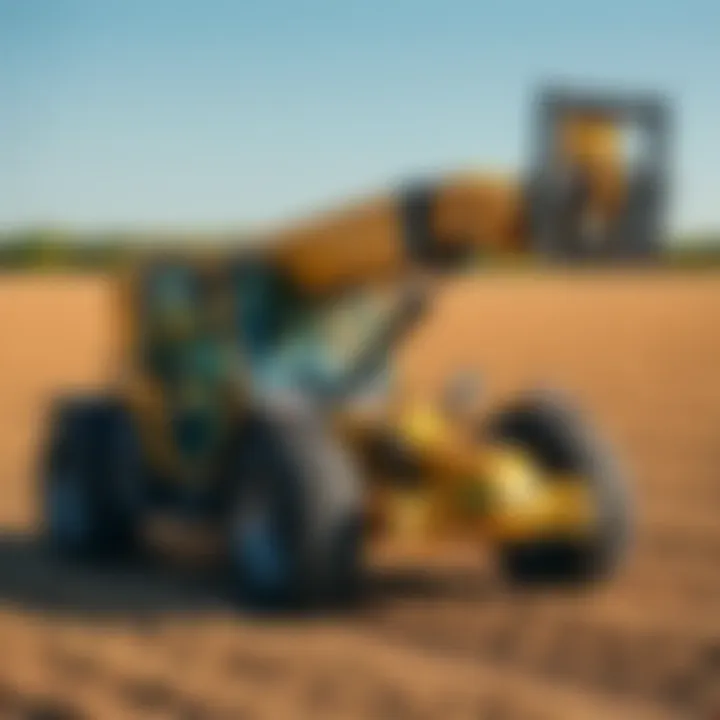
- Adaptability: The telehandler's multifunctional capabilities enabled the farm to efficiently respond to changing market needs.
- Labor Efficiency: Tasks that previously required several different pieces of equipment could now be done more efficiently, reducing labor costs and time.
- Operational Capacity: The telehandler's reach and lifting power opened opportunities for growing a variety of crops previously deemed impractical due to logistical constraints.
By diversifying their operations and leaning into the capabilities of a used telehandler, Farm A not only expanded its crop offerings but also positioned itself favorably against competitors.
Farm B: Cost Savings Analysis
Farm B, known for its dairy production in the heart of Wisconsin, offers a compelling contrast. This farm initially relied on a fleet of more specialized machinery for its day-to-day operations. However, as the costs of maintenance and fuel began to pile up, Farm B's owner realized a shift was necessary.
Investing in a used Manitou telehandler proved to be a game-changer. The decision was driven by cost savings in several dimensions, including:
- Operational Costs: By consolidating various tasks into one piece of equipment, Farm B drastically cut down on the maintenance costs associated with multiple machines.
- Fuel Efficiency: The telehandler's design allowed it to perform heavy lifting operations with significantly less fuel consumption compared to older tractors.
- Versatility: From moving bales to cleaning up around the barns, this multifunction appliance reinvigorated operational efficiency on the farm.
Farm B's experience underscores how strategic investment in used telehandlers can lead to better resource management. The savings incurred enabled the owner to reinvest in additional farming technologies that further improved the business.
In summary, these case studies exemplify the substantial impact that used telehandlers can have in diversifying operations and providing notable cost savings. With proper consideration of their specific farming needs and operational goals, farmers can leverage telehandlers to not only enhance productivity but also to achieve financial sustainability.
This approach to case studies underscores the importance of evidence-based decision-making for farmers considering used telehandlers as part of their farming strategy.
Future Trends in Telehandler Use
The landscape of agriculture is shifting rapidly, and the role of telehandlers is evolving in dynamic ways. As farmers grapple with challenges ranging from labor shortages to climate variability, understanding the future trends of telehandler use becomes essential for maximizing productivity and sustainability. This section delves into the notable trends shaping the telehandler market, focusing on technological advancements and the dynamics of market demand.
Technological Advancements
Telehandlers are no longer just simple lifting machines; they have transformed into technologically sophisticated pieces of equipment. The integration of smart technology into telehandlers enhances not only their functionality but also their safety and efficiency.
Important technological trends include:
- Telematics: Many new telehandlers come equipped with telematics systems that track performance metrics in real-time. This allows farmers to monitor fuel consumption, operational hours, and even maintenance needs from their smartphones or computers.
- Automation: Automation is increasingly influencing telehandler designs. Features like load sensing, automatic steering adjustments, and remote control operations help in improving ease of use. Farmers can now operate telehandlers with greater precision, reducing the risk of accidents and improving overall efficiency.
- Energy Efficiency: Manufacturers are investing in hybrid models that combine traditional fuel-powered engines with electric motors. Enhanced energy efficiency translates into lower operational costs, which is a crucial factor for farmers working on tight margins.
"Innovation pushes the agility of agricultural machinery, making farming not just easier, but smarter."
Investing in these advanced models not only optimizes productivity but also aligns with broader environmental goals, making it a wise choice for future-focused farmers.
Market Demand Dynamics
Understanding the shifts in market demand provides insight into how telehandlers will be utilized moving forward. Several factors influence the demand for used telehandlers, including:
- Growing Diversification in Farming Operations: As farms become more diversified, the necessity for versatile machinery increases. Used telehandlers can adapt to various tasks - from loading and transporting feed to managing materials for construction projects on farms.
- Cost Sensitivity: Price remains a significant factor for farmers, especially smaller operations. The demand for used telehandlers continues to be robust as farmers seek cost-effective solutions without compromising quality. They are looking for equipment that offers both durability and advanced features, which often can be found in the second-hand market.
- Post-Pandemic Recovery: The COVID-19 pandemic has resulted in altered consumer behaviors and pressures on supply chains. Farmers aim to recover and grow their output as markets stabilize. Used telehandlers offer these farmers a way to quickly enhance their machinery fleet without extensive capital investment.
In summary, as the agricultural landscape grows and changes, telehandlers stand at the forefront of innovation and adaptability. By understanding both technological advancements and market demands, farmers can make informed decisions in their telehandler investments, ultimately enhancing their operational efficiency and ensuring sustainability in their practices.
Epilogue
In summarizing the discussion on used telehandlers within the agricultural landscape, we can glean a solid understanding of their importance and the myriad of advantages they provide. It is vital to recognize how these machines operate as a bridge between traditional practices and modern efficiency. Used telehandlers are not merely tools; they represent a strategic investment that can enhance both productivity and sustainability in farming operations.
Summary of Key Insights
The examination of used telehandlers has brought to light several key insights:
- Cost-Effectiveness: Acquiring used equipment significantly lowers upfront costs, allowing farmers to allocate budget to other necessary enhancements on their farms.
- Advanced Features: Many used telehandlers come equipped with sophisticated features that facilitate a variety of tasks, increasing their utility without the need for brand-new machines.
- Sustainability Impact: By opting for used equipment, farmers contribute to a circular economy, reducing waste and promoting sustainable farming practices.
Moreover, the enhancement of operational capacities via better accessibility and lifting abilities cannot be overstated. These machines enable farmers to tackle demanding tasks, reduce labor costs, and improve overall output.
Final Thoughts on Sustainability and Efficiency
As agriculture progresses, the push for sustainability and enhanced efficiency becomes ever more crucial. The choice to purchase used telehandlers not only aligns with these ideals but actively promotes them. By extending the lifecycle of machinery through resale and re-use, we mitigate environmental impact while achieving agricultural goals.
Furthermore, as farmers adapt to changing market dynamics, the ability to be agile and cost-conscious will define future successes. Thus, selecting the right used telehandler can very well lead to a turning point in operational effectiveness.



